20 Business email examples to elevate your professional correspondence
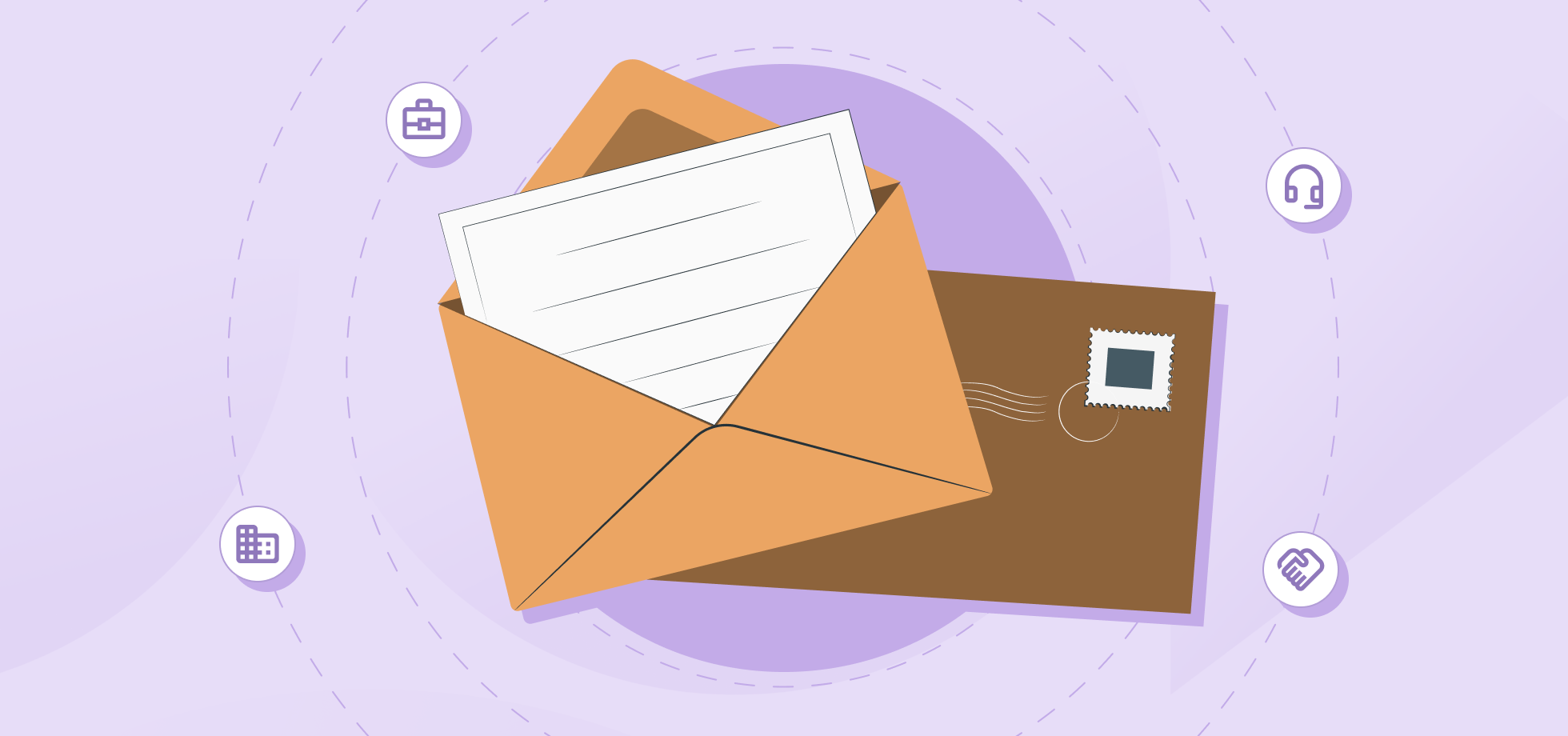
Business email examples are crucial for anyone looking to communicate effectively in a professional setting. Whether you’re reaching out to a new client, following up on a meeting, or making a request, the way you craft your emails can make a big difference.
As email usage continues to grow — projected to reach around 4.6 billion users worldwide by 2025 — effective email communication is more important than ever.
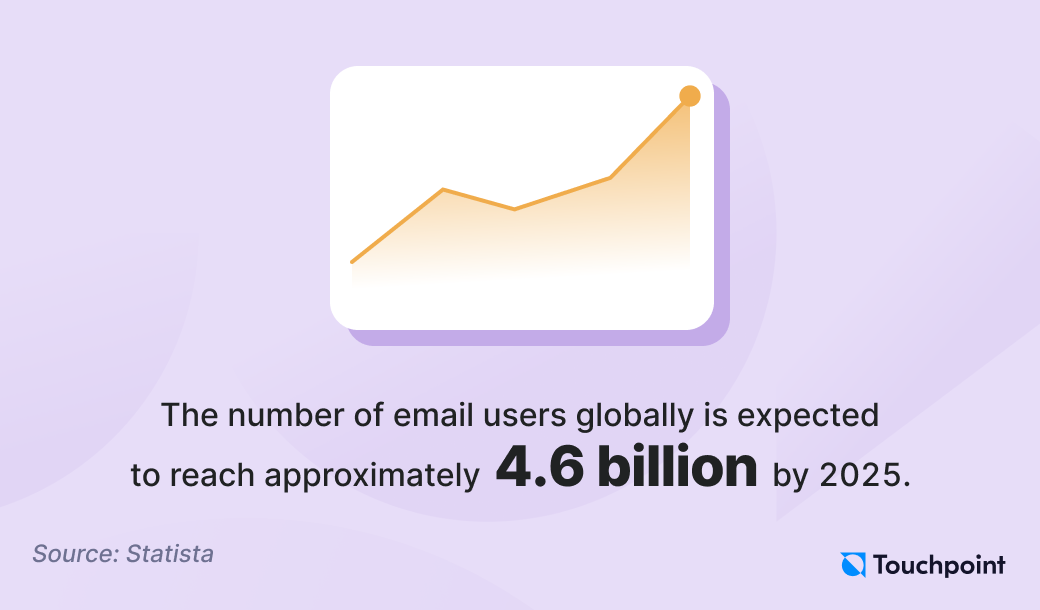
In this blog post, we’ve gathered 20 business email examples to help you improve your professional correspondence. From introductory communication to follow-up emails and everything in between, our selection of business email examples provides practical insights and actionable tips for writing compelling emails.
Let’s start with the fundamental question.
What is a business email?
A business email is a type of email used for professional communication. It’s often sent between colleagues, customers, or partners. It can cover various topics, like updates, requests, or important announcements.
Business emails are different from other types of emails. Here is how they differ.
- Purpose: Business emails are formal and focused on work-related topics. Personal emails are more casual and can discuss anything.
- Tone: Business emails use a professional tone. Personal emails can be relaxed and friendly.
- Structure: Business emails usually follow a clear structure. They often have a greeting, body, and closing. Personal emails can be more free-form.
- Audience: Business emails are sent to coworkers or clients. Personal emails are for friends or family.
💌 Professionalism in business emails establishes credibility and respect, ensuring that your messages reflect well on your personal brand and organization. Clarity in these communications prevents misunderstandings and saves time for all parties involved. Focus on both to drive successful outcomes.
20 business email examples to inspire you
The following list contains business email examples from various companies to help you get started. We’ve even interacted ourselves with some of the companies on the list.
Check what makes each email work so you can adapt it to your own needs.
1. LinkedIn — outreach email

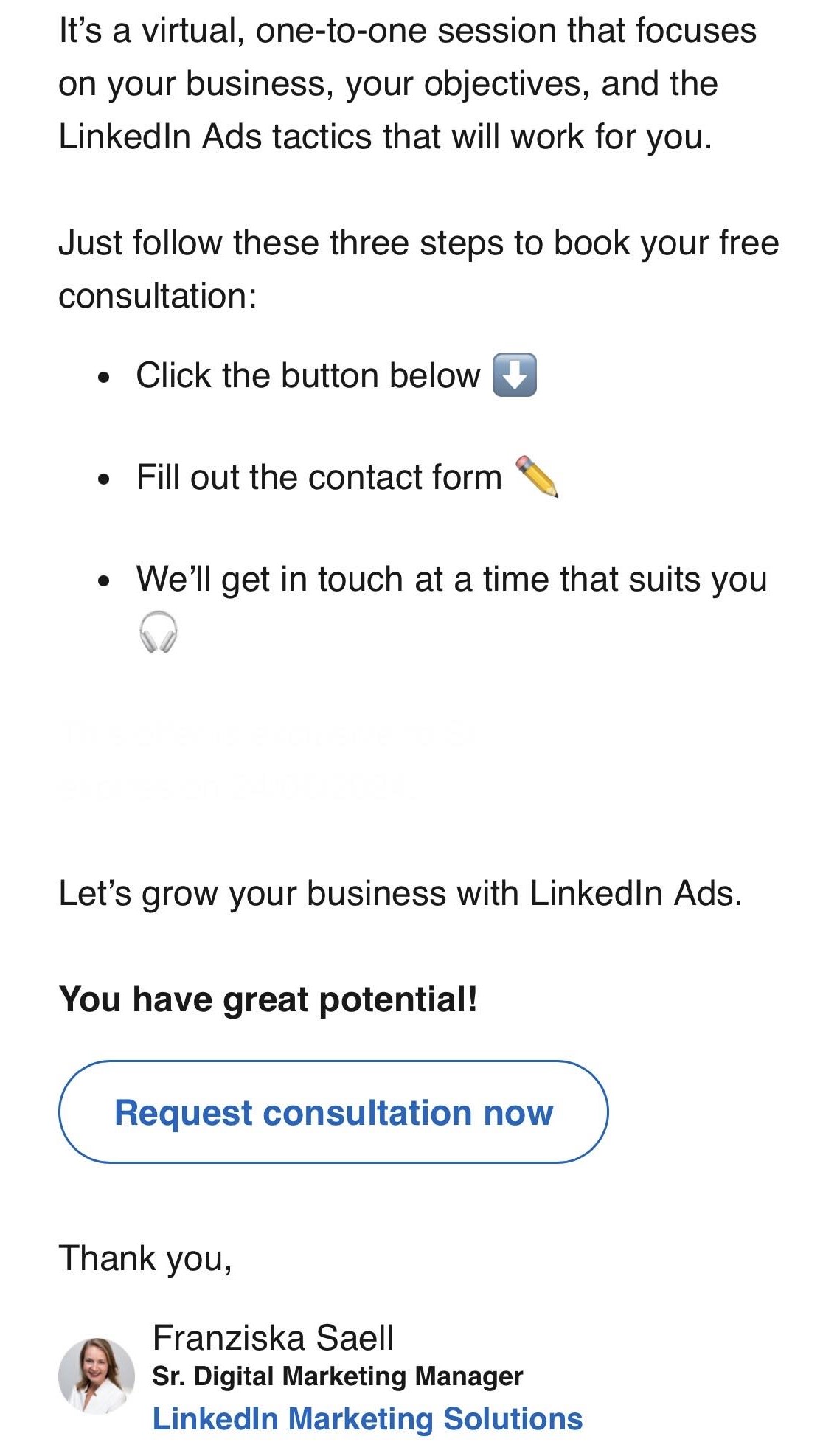
Why it stands out
- This communication showcases a professional format that you can use as a model for similar outreach efforts.
- The email clearly outlines the benefits of LinkedIn Ads. It shows how the consultation can help the recipient by addressing potential pain points.
- It’s a great email format example, showcasing a clear and structured layout with a compelling call to action (CTA).
2. NET-A-PORTER — apology email
 PORTER business email example" width="1179" height="1751" />
PORTER business email example" width="1179" height="1751" />
Why it stands out
- The email starts with a clear acknowledgment of technical problems. This shows that the company is aware of the issue and values transparency.
- By offering a discount, the company not only apologizes but also compensates the customers for the inconvenience.
- It’s one of the few business email examples that shows how to handle a technical issue with a clear apology, a compensatory offer, and a friendly tone to maintain customer loyalty.
3. Singapore Airlines — appreciation email
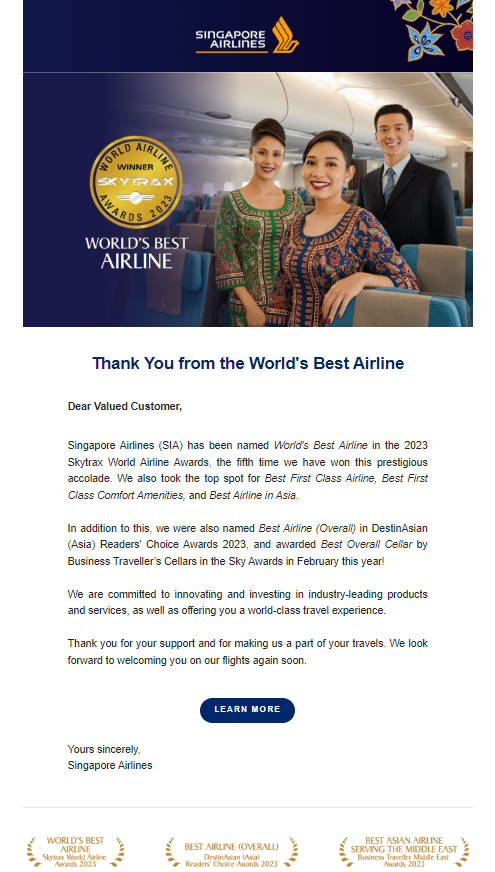
Why it stands out
- The email aligns with standard company emails by reflecting the organization’s commitment to excellence.
- By thanking customers for their support, the email creates a sense of community and appreciation.
- It has a professional email layout and a formal tone throughout, which is appropriate for addressing loyal customers and celebrating achievements.
4. Bank of America — confirmation email
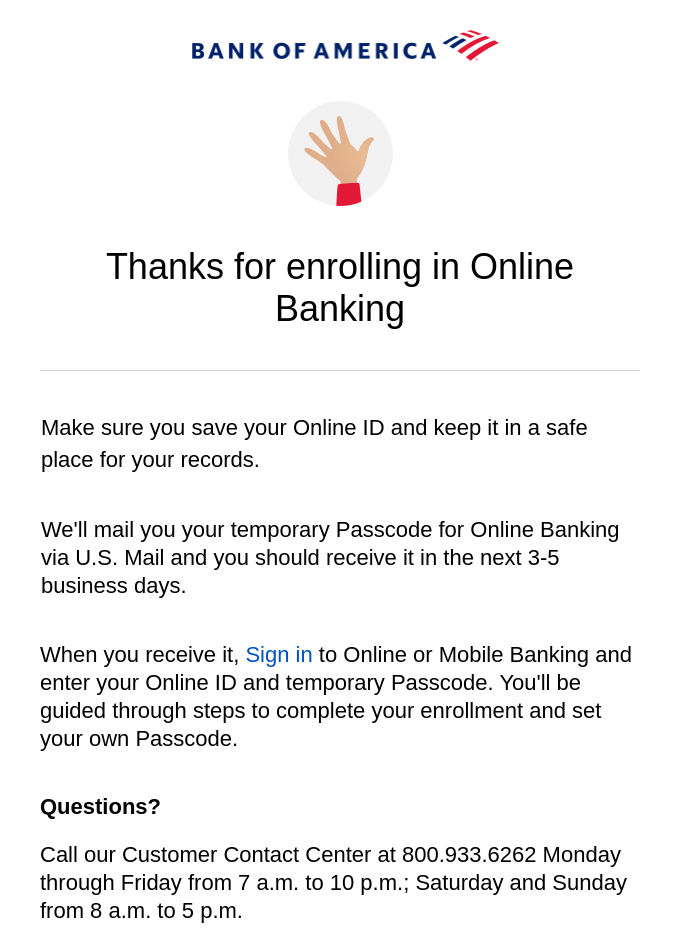
Why it stands out
- The email uses a formal and respectful tone appropriate for communication from a banking institution. It helps build trust and credibility.
- The email includes a warning about not sharing personal information, which is crucial for protecting sensitive data.
- It serves as a confirmation of the recipient’s enrollment in online banking, reassuring them that the process is in progress and providing the next steps.
5. Stripe — update email
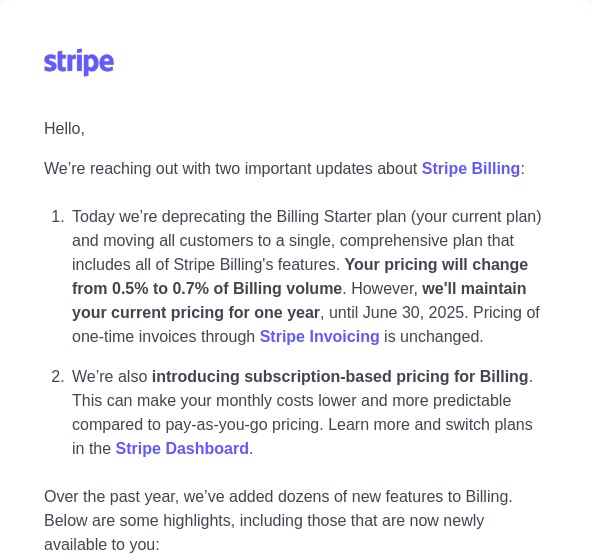
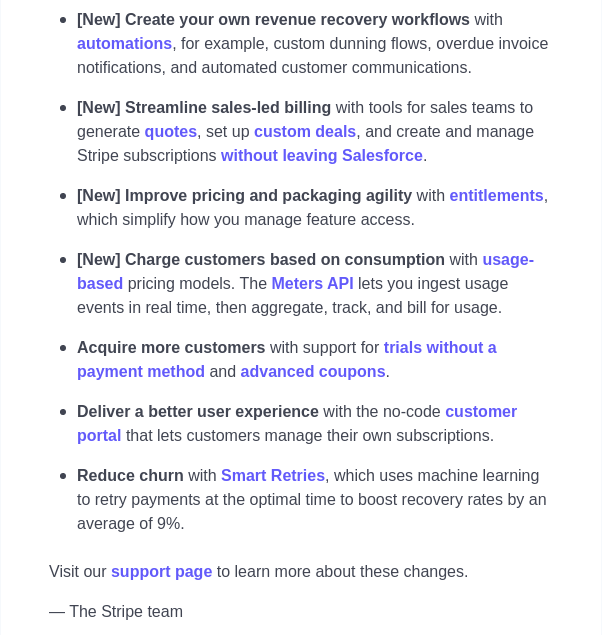
Why it stands out
- The email provides specific updates about changes to the billing plan. It introduces new features relevant to the recipient’s business operations.
- The email uses a professional and formal tone consistently, aligning with the email format examples used for effective business client communication.
- It’s a great business email example of structuring content well, combining detailed information with actionable steps in a clear format.
6. Partnero — announcement email
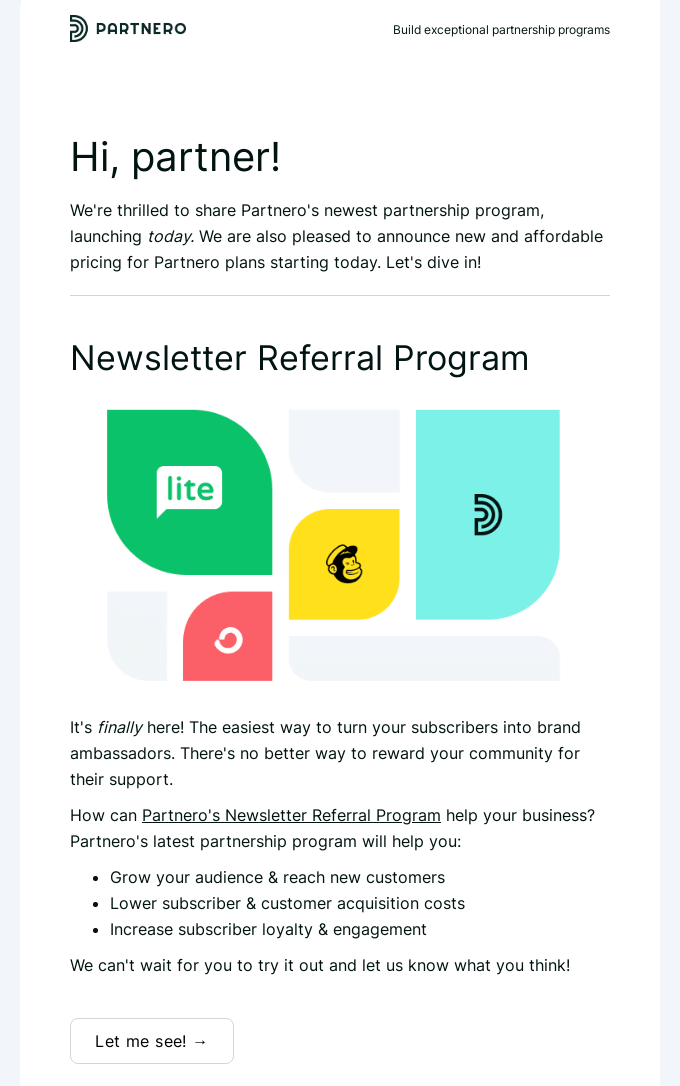
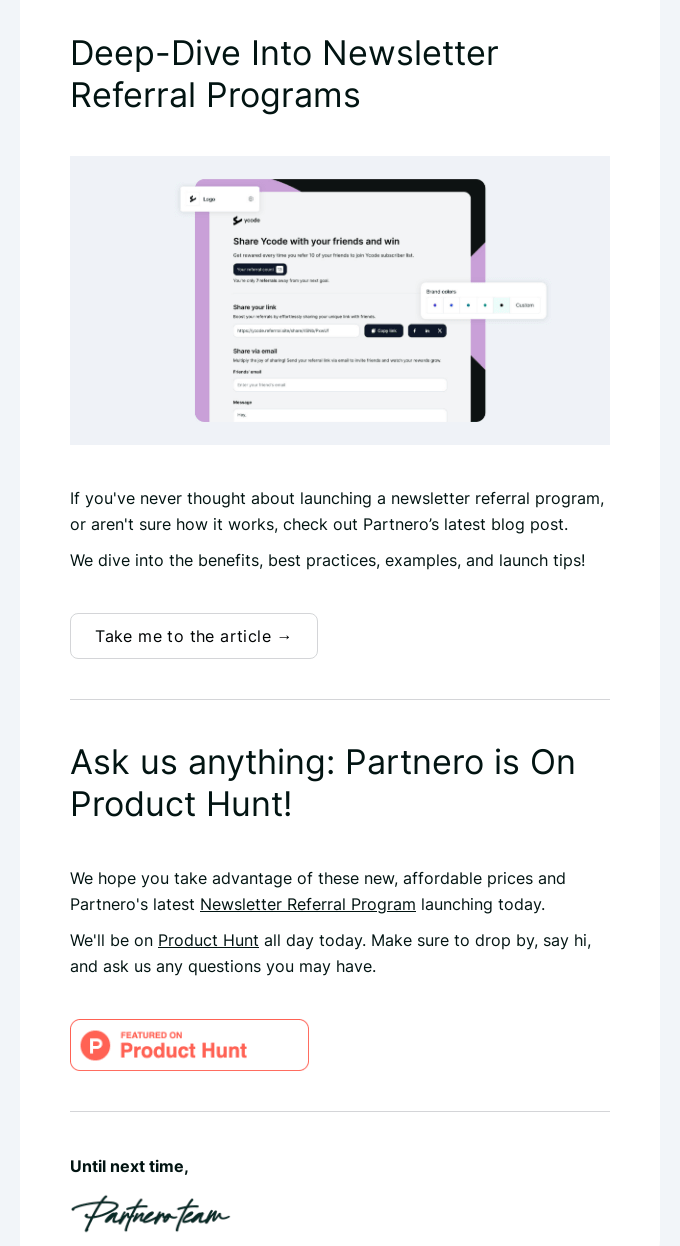
Why it stands out
- Despite the friendly tone, the email maintains a structured format typical of business communications. It includes sections and bullet points for clarity.
- The content is specifically tailored for partners and potential clients, reflecting a focus on business relationships and opportunities.
- It features the company’s name, branding, and promotion of its presence on Product Hunt.
7. Fitbit — appreciation email
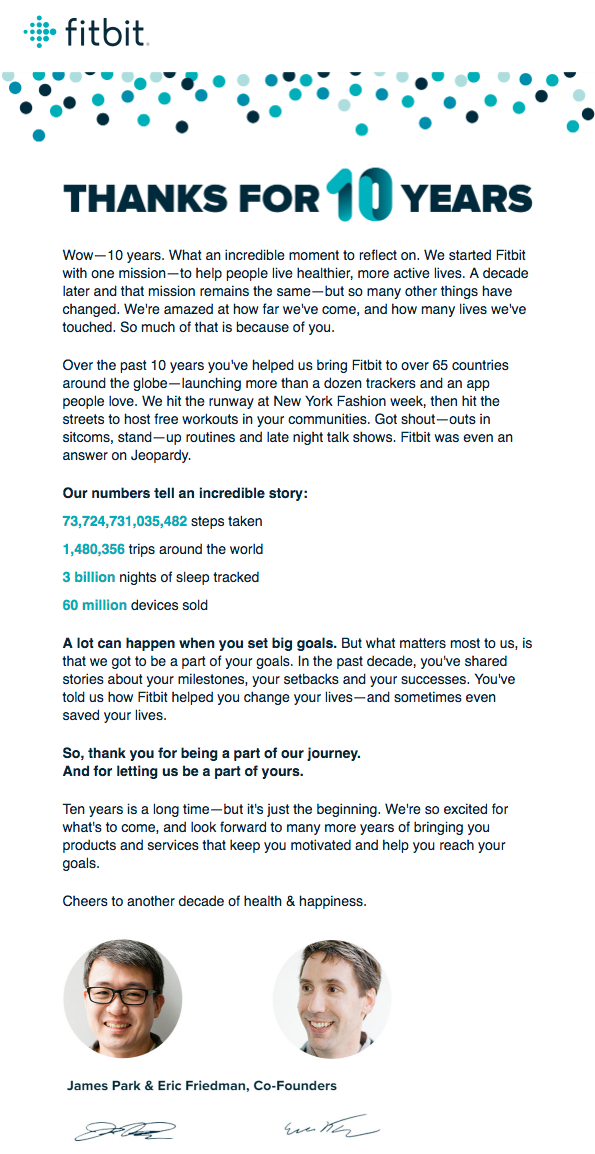
Why it stands out
- This email stands out as one of the best company email examples. It combines heartfelt gratitude with impressive achievements to inspire customers.
- It looks forward to the future, creating excitement for what’s to come and encouraging continued customer engagement and support.
- It is signed by the co-founders, adding a personal touch while reinforcing the message’s authenticity and credibility.
8. Uber — webinar invitation email
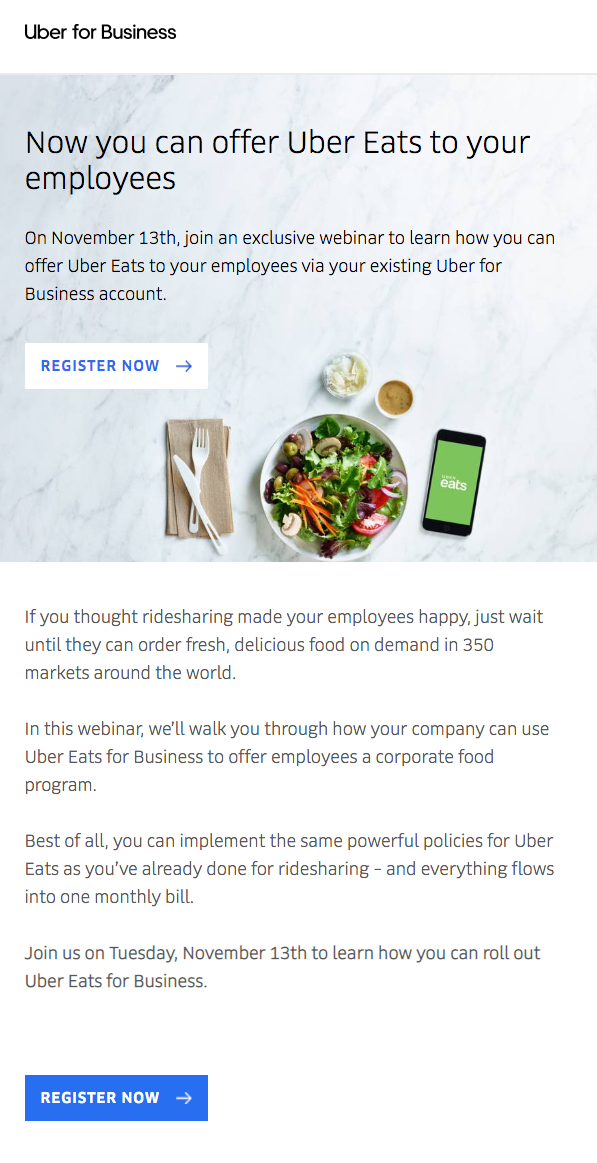
Why it stands out
- The email maintains a professional tone and a well-organized format, making it easy for recipients to understand the offer.
- It provides details about the webinar date, content, and benefits of the service, making it relevant for business decision-makers.
- The business email explains that Uber Eats can be integrated into the existing Uber for Business account, with the same policies and billing structure as ridesharing services.
9. Inc. Magazine — program invitation email
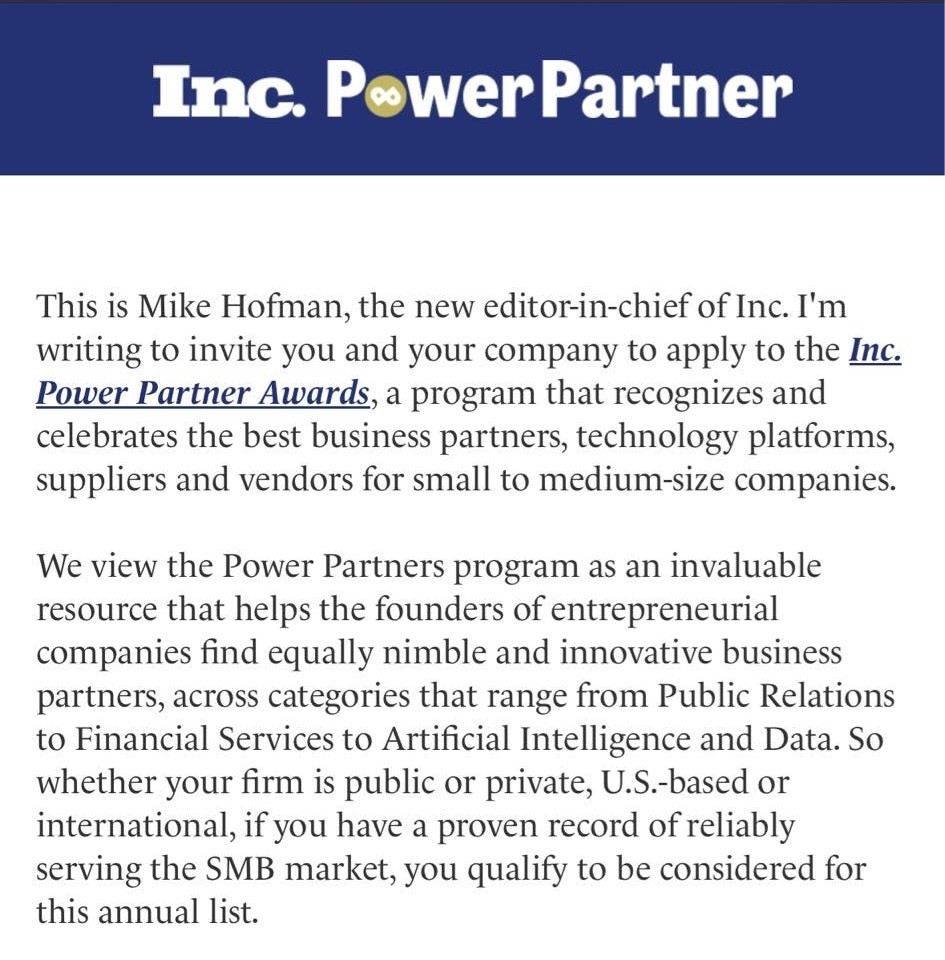
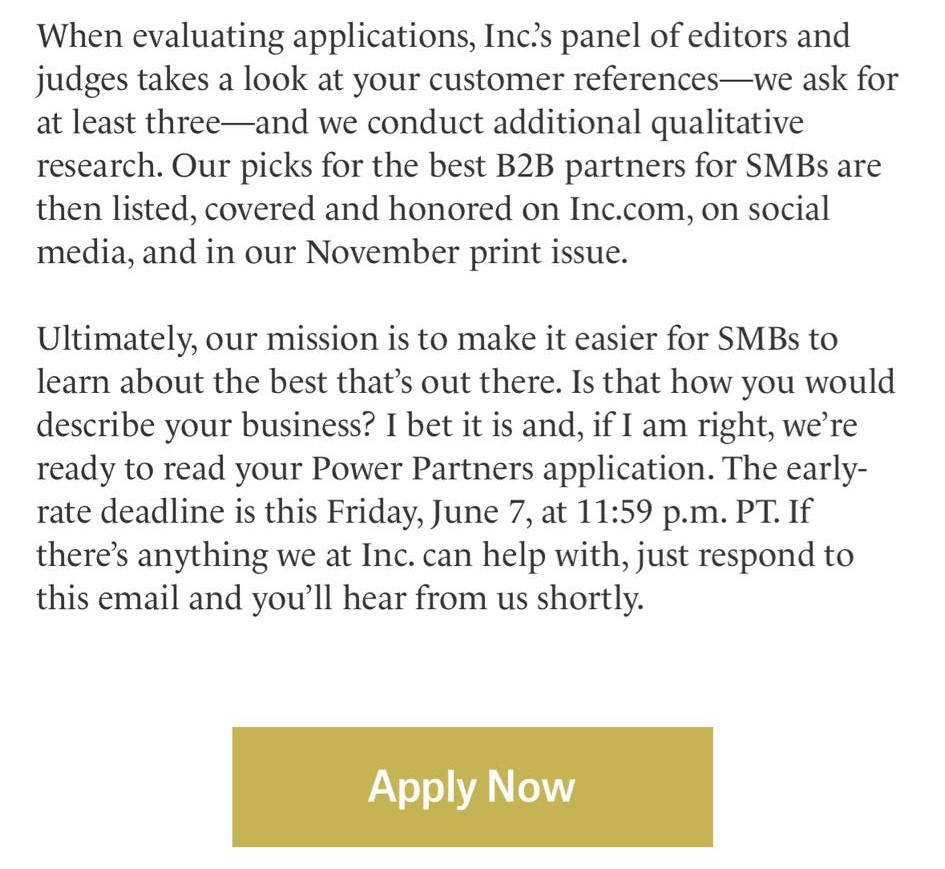
Why it stands out
- The email follows professional email writing examples with a well-organized structure. It invites the recipient to apply for the Inc. Power Partner Awards.
- The email outlines the benefits of participating in the awards, such as increased visibility and recognition. This adds value for the recipient.
- It mentions a specific deadline that encourages timely action.
10. Webflow — customer nurturing email
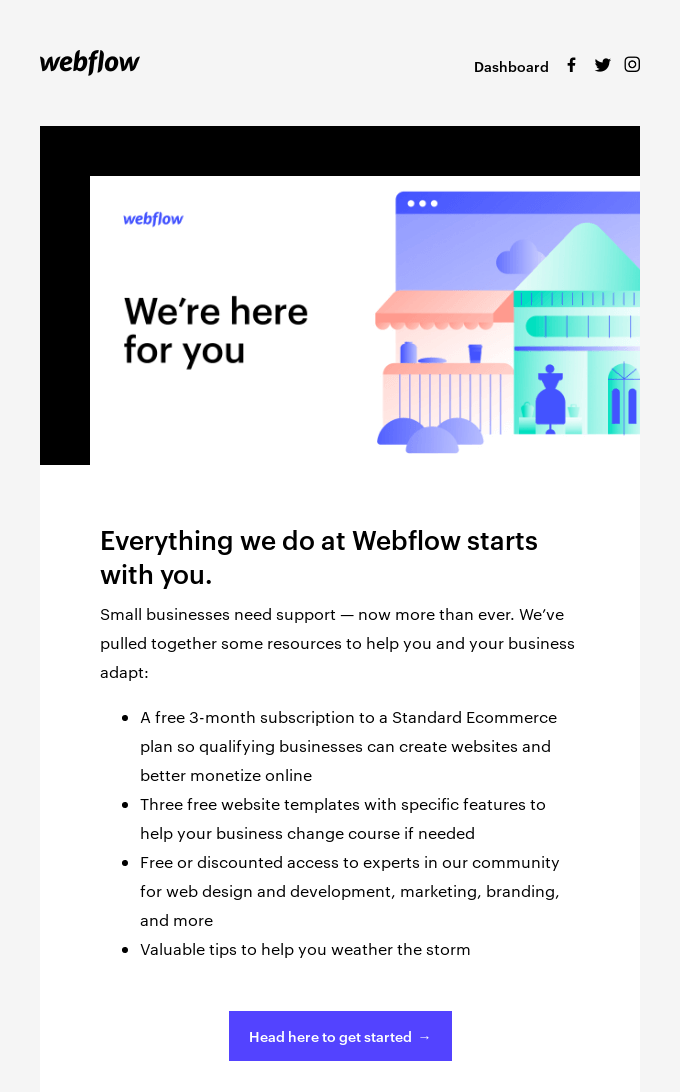
Why it stands out
- Instead of vague promises, the message outlines concrete, valuable resources — free subscriptions, templates, expert access, and valuable tips.
- The message emphasizes, “Everything we do at Webflow starts with you,” clearly highlighting their customer-centric approach.
- The email emphasizes support and assistance, which helps build trust.
11. TechBehemoths — survey invitation email
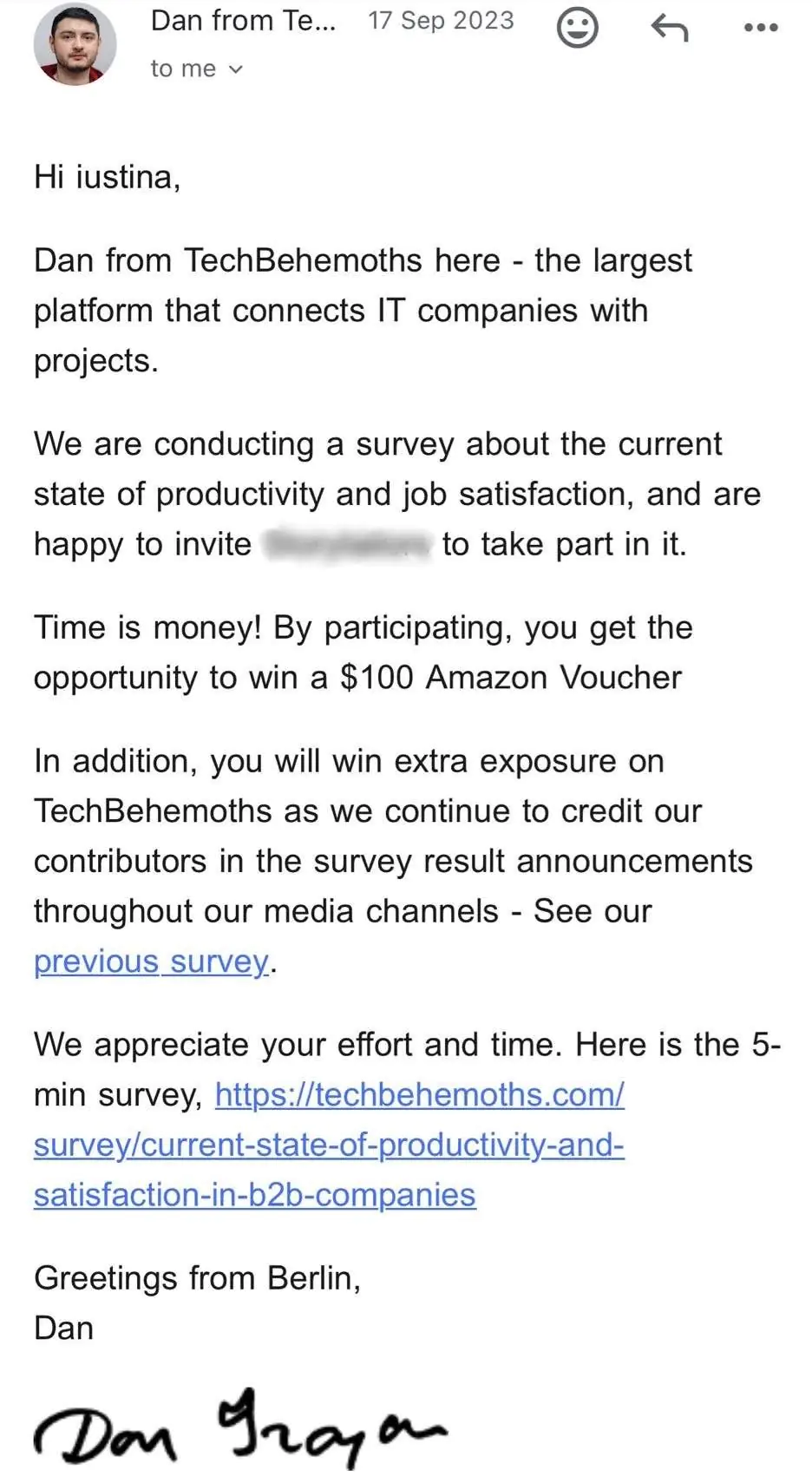
Why it stands out
- The overall tone is professional and respectful, suitable for business communication.
- The email highlights the benefits of filling in the survey, which adds value to the recipient.
- It addresses the recipient by name and also includes a personal sign-off, which makes the message feel more genuine.
12. Amazon — gift card email
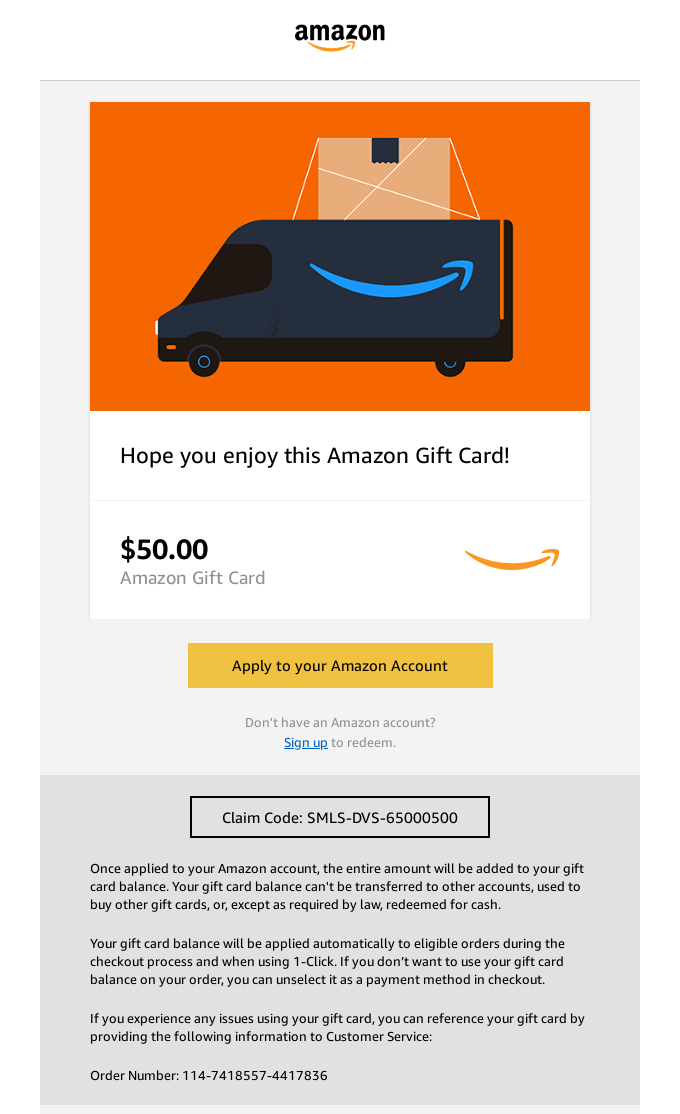
Why it stands out
- The email follows a clear email structure example, with distinct sections for the claim code, redemption instructions, and support information.
- The tone is neutral and formal It is appropriate for business correspondence, even in the context of offering a gift card.
- The business email includes privacy-related information to avoid misunderstandings, such as not redeeming the card for cash.
13. Shopify — customer nurturing email
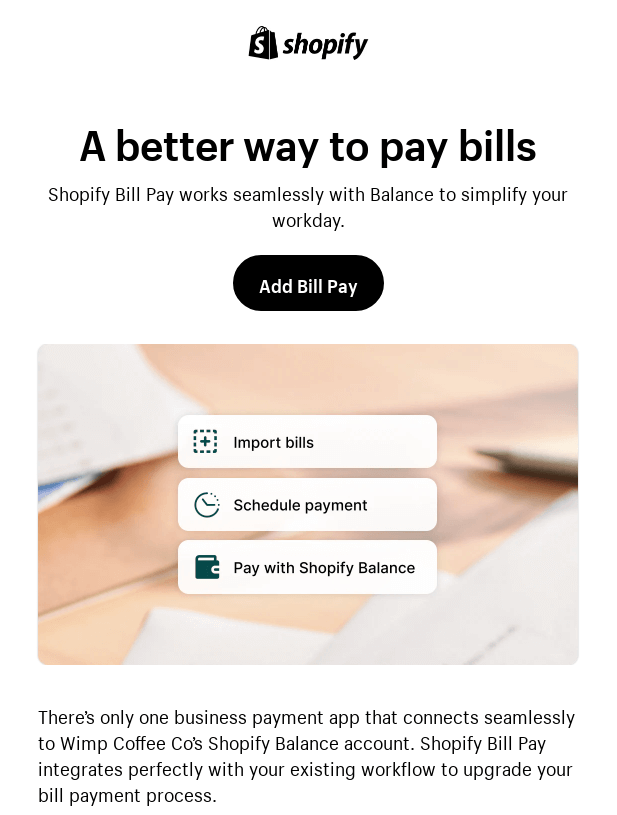
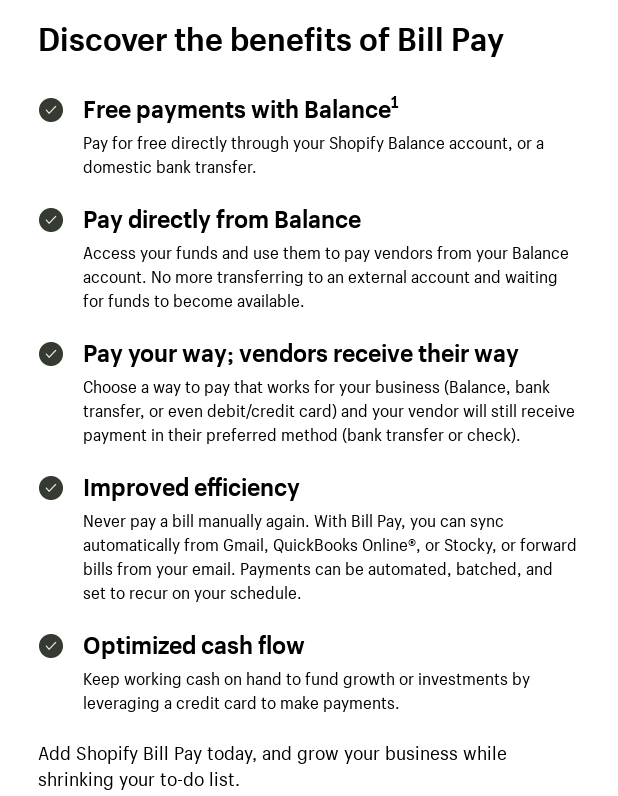
Why it stands out
- The email maintains a professional and persuasive tone throughout, suitable for communicating with business clients and partners.
- It directly addresses business needs, focusing on how Shopify Bill Pay can streamline bill payments and improve efficiency.
- It explains how Shopify Bill Pay integrates seamlessly with existing workflows, mentioning specific tools like Gmail, QuickBooks Online, and Stocky.
14. Shop App — app downloading email
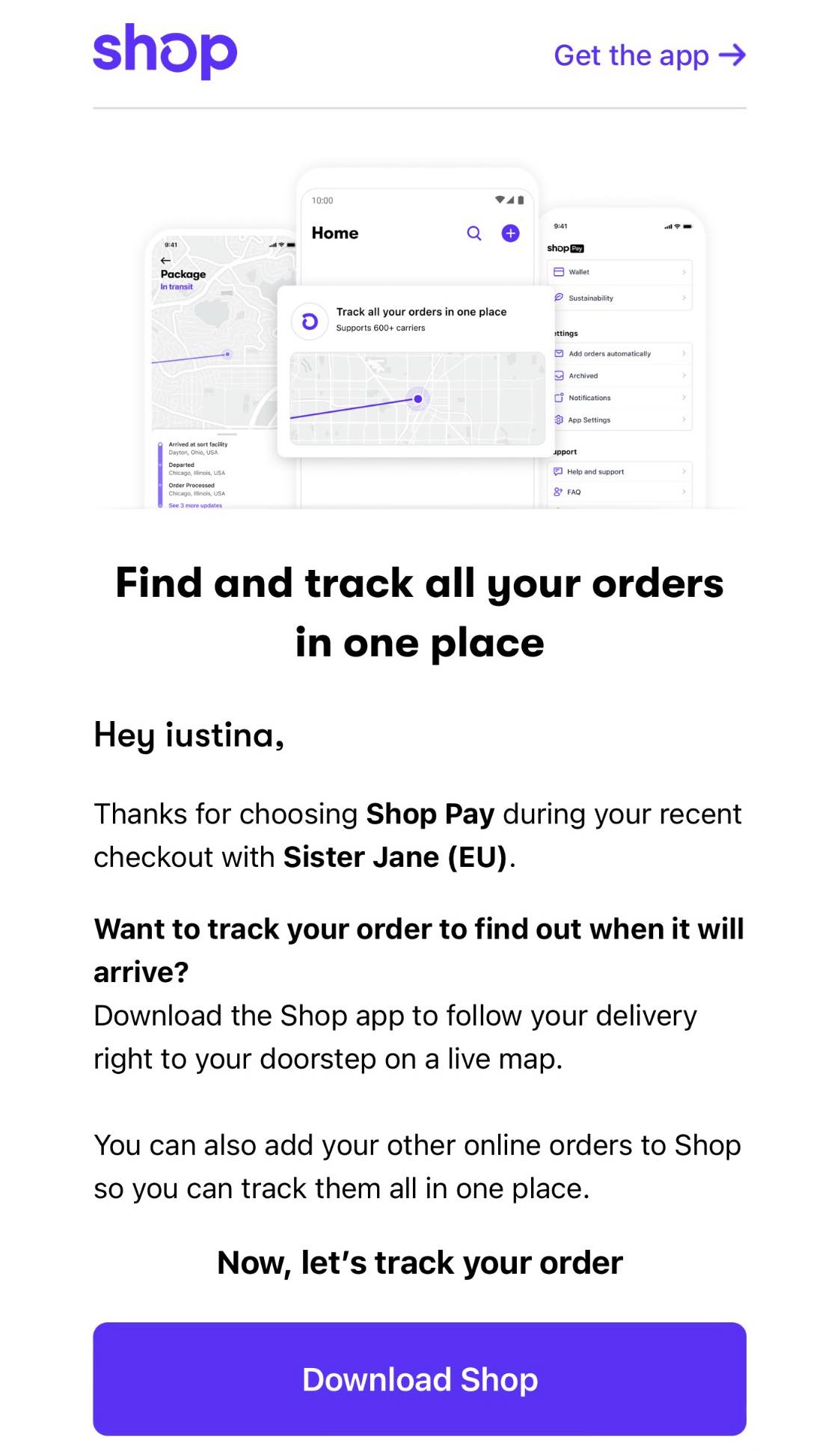
Why it stands out
- The email references the recent use of Shop Pay and the associated order with Sister Jane. It links its content to the recipient’s recent transaction.
- It follows a clear business email format example, with clear instructions on how to track orders and download the Shop app.
- It invites the recipient to track all their online orders in one place, improving their shopping experience.
15. Nordstrom — customer service email
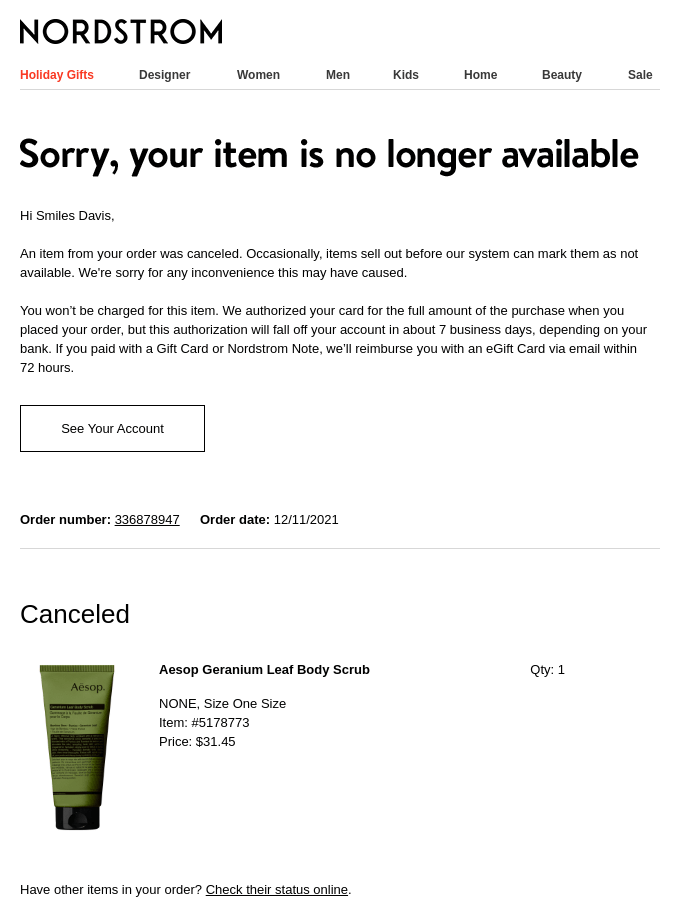
Why it stands out
- The email apologizes for the inconvenience caused by the cancellation, making it an example of good customer service.
- It provides clear information about the payment status and how the refund will be processed.
- It follows an effective email template for business communications that builds trust and reliability with customers.
16. Clutch — review invitation email
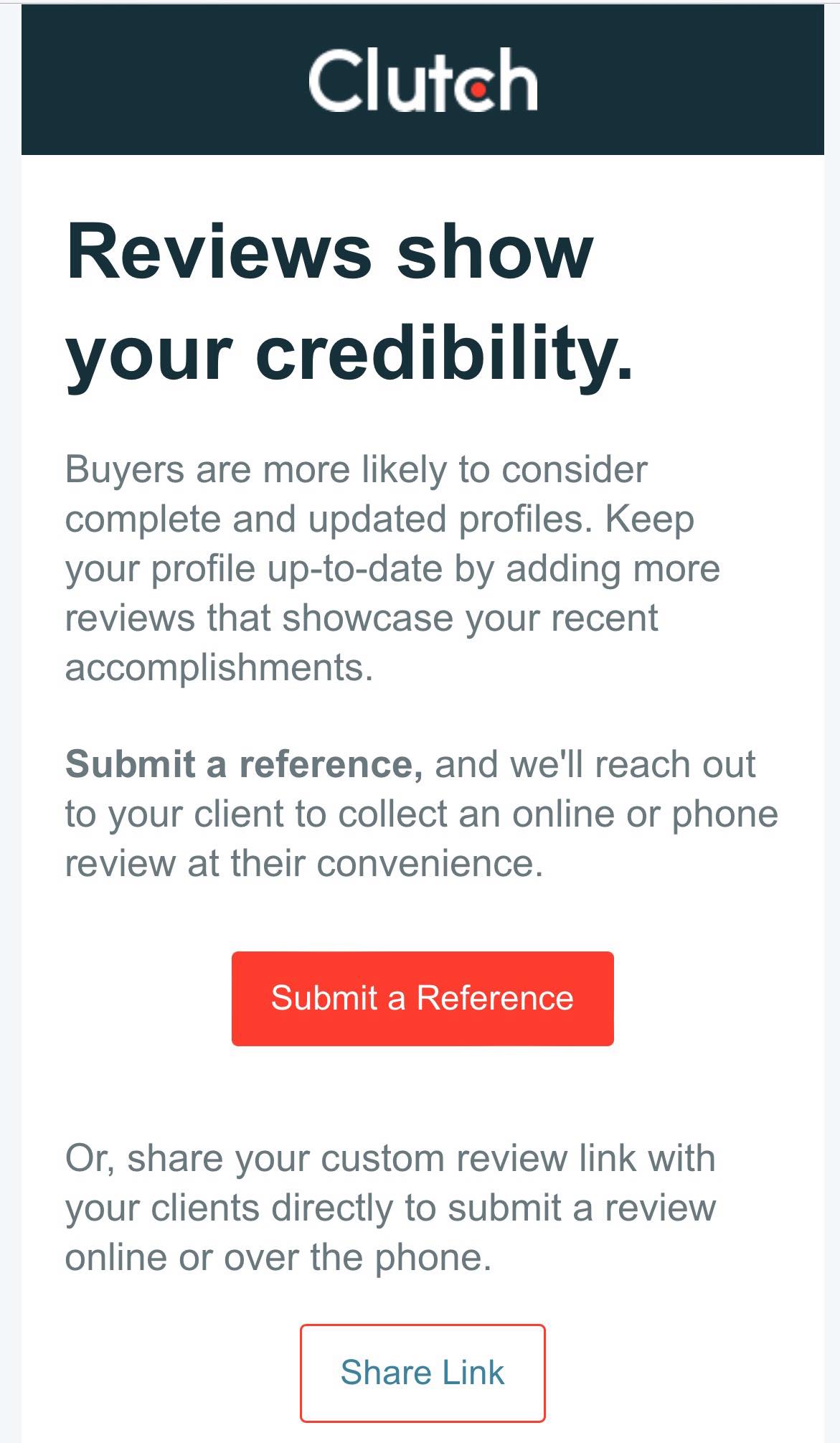
Why it stands out
- The email has a clear objective — encouraging the recipient to update their profile and submit reviews.
- It provides action-oriented guidance, reflecting an email style that focuses on actionable steps to engage the recipient.
- Mentioning Clutch as a platform for reviews and credibility reinforces the business-focused nature of the communication.
17. Mytheresa — customer service email
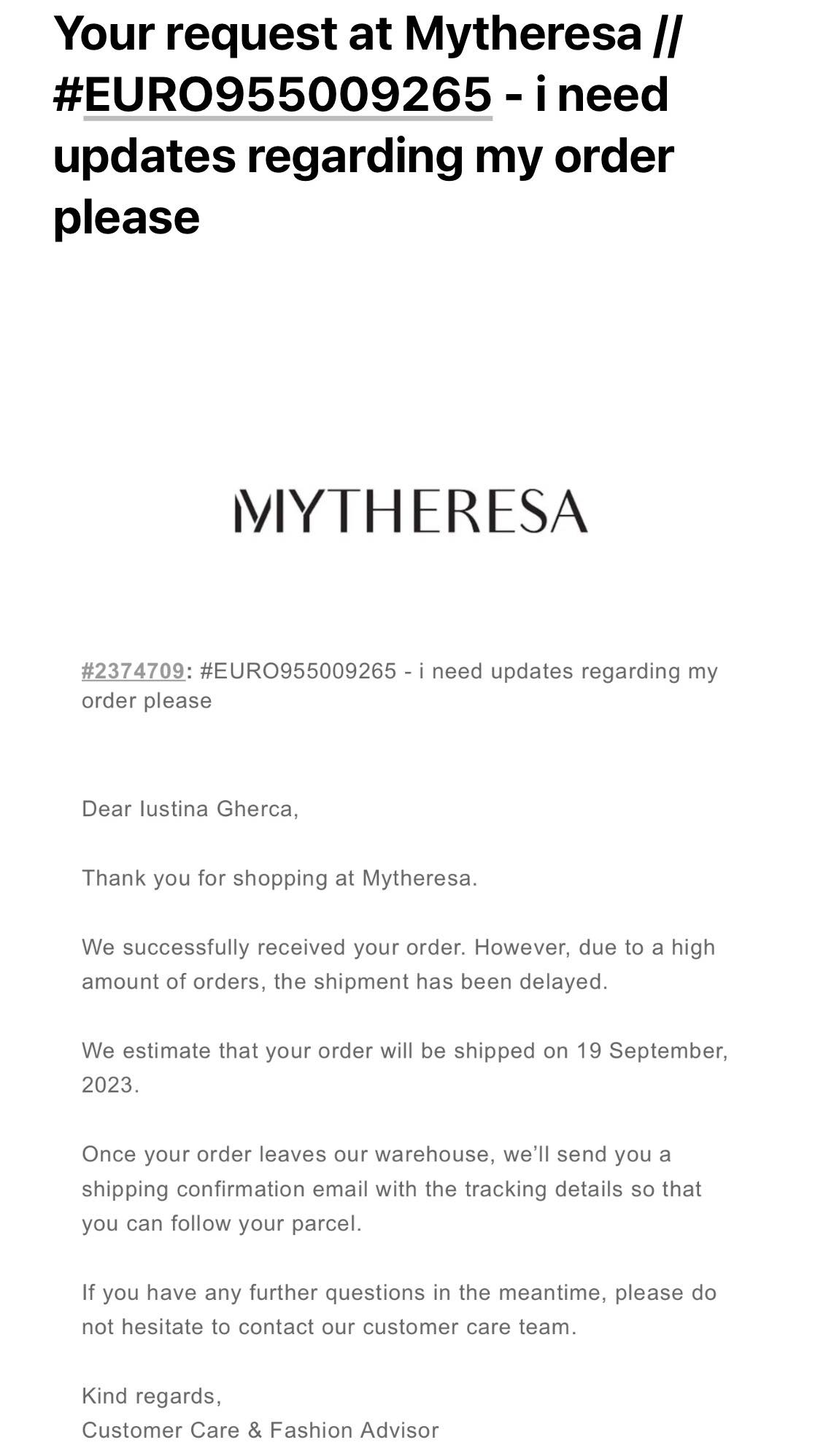
Why it stands out
- The email acknowledges the delay in shipment and apologizes for the inconvenience, demonstrating excellent customer service practices.
- It assures the client that a shipping confirmation email with tracking details will be sent once the order ships.
- The email ends with a formal sign-off and includes the department’s designation, adding to its professional tone.
18. Livestorm — survey invitation email
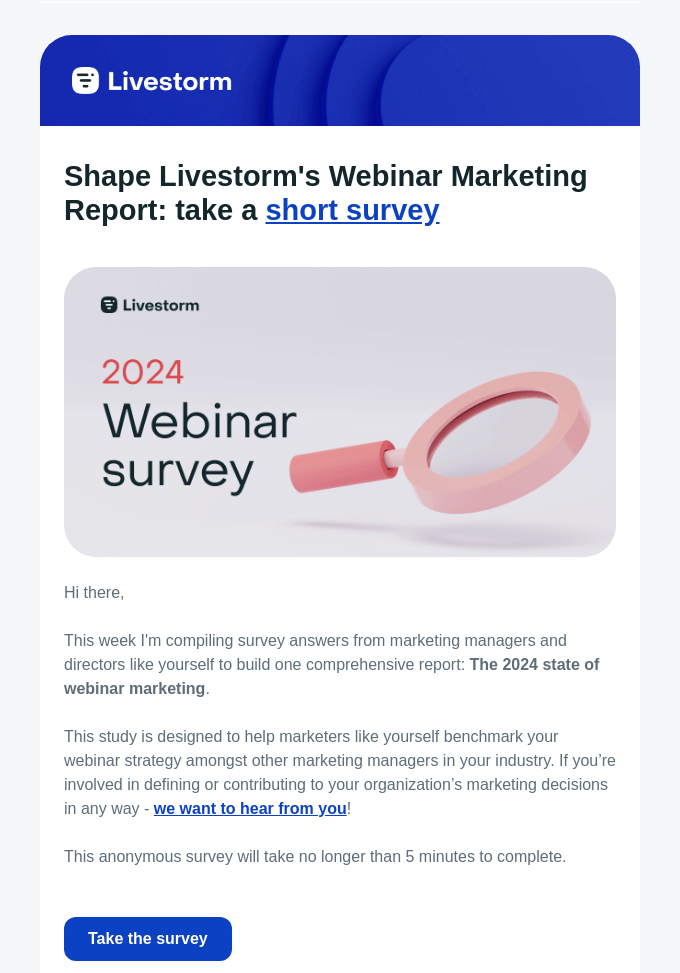
Why it stands out
- The language used is formal and professional, appropriate for a business context.
- The email includes a CTA that urges recipients to participate in a survey — a common practice in business communications.
- It highlights the benefit of participating, that is, helping marketers benchmark their webinar strategy against industry standards.
19. Blinkist — announcement email
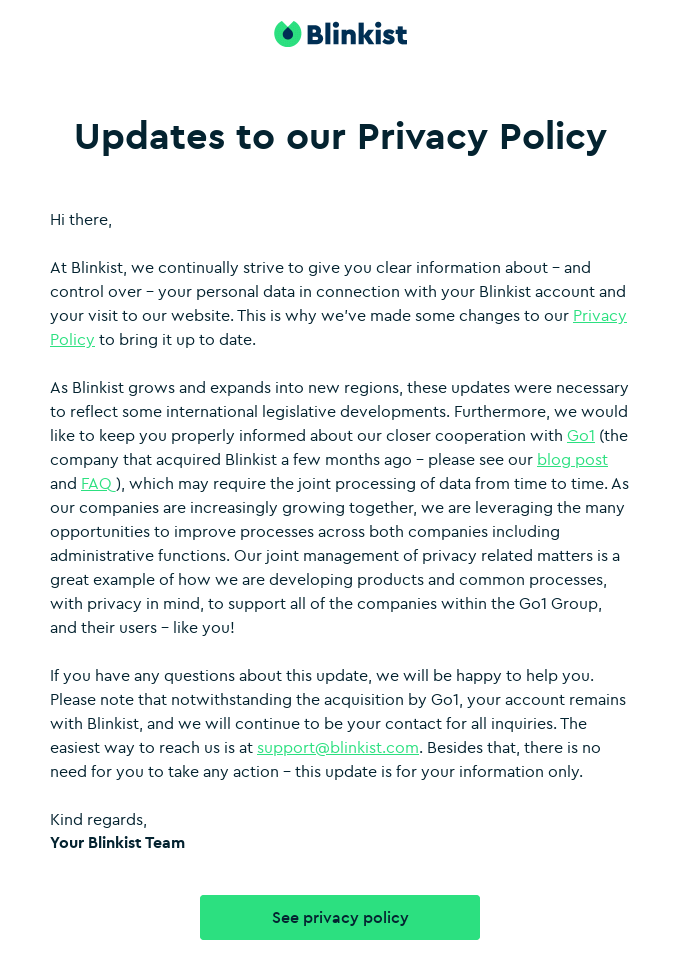
Why it stands out
- The email provides a clear rationale for the updates to the privacy policy and how these changes affect the company’s data management practices.
- It reassures recipients about continuity and stability. Blinkist states that despite the acquisition, it still remains the point of contact.
- The structure makes the message easy to understand, with simplified language that explains complex issues like data processing and privacy.
20. Textmagic — welcome email
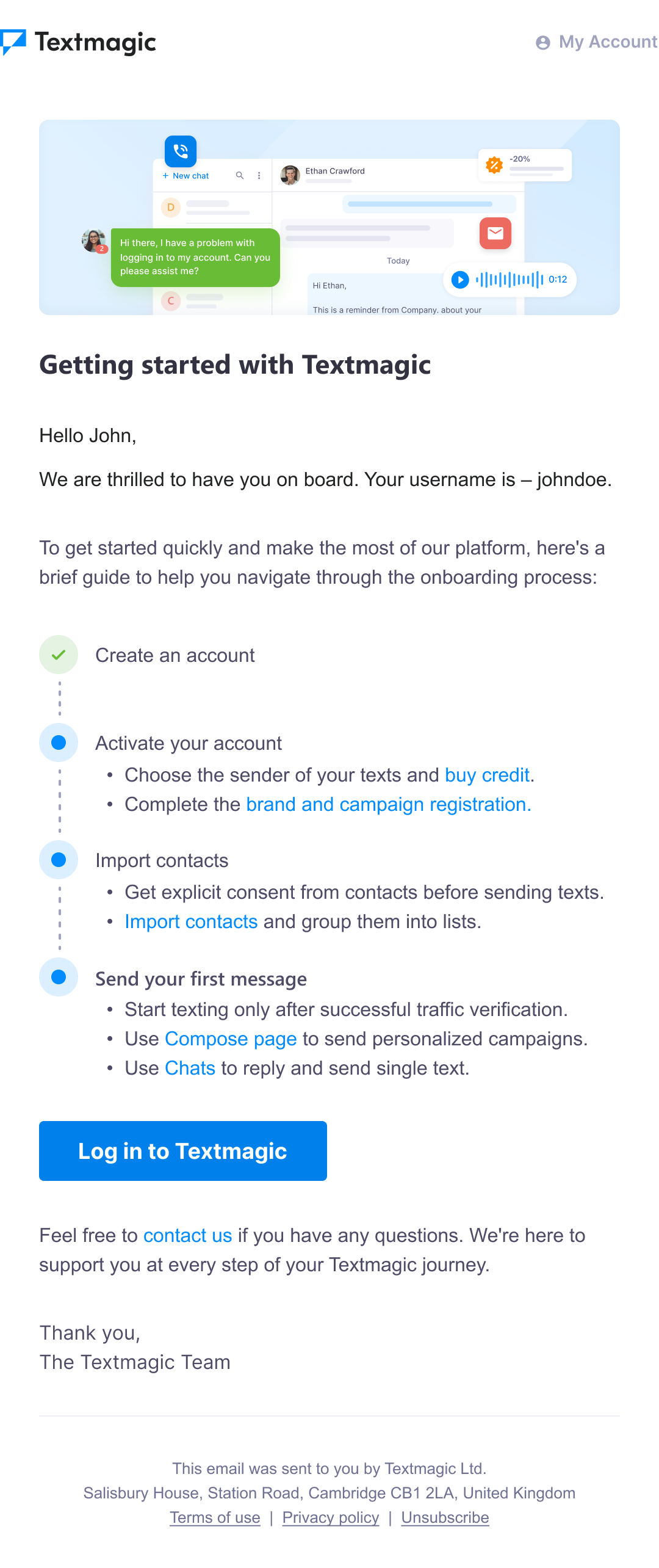
Why it stands out
- Our welcome email maintains a professional yet friendly tone, which is perfect for business communication.
- Each step in the customer onboarding process includes specific actions that the user needs to take, helping them understand what to do next.
- The key features of our platform — sending personalized campaigns and replying to texts — are clearly explained.
How to write a business email
This is how you write a professional business email that is simple and approachable.
1. Understand your audience
Knowing who your recipient is can greatly influence how you formulate your email. Here’s how to tailor it depending on their role, their relationship with you, and their expectations.
- For colleagues: Use a friendly yet professional tone.
- For clients: Maintain a polite and respectful tone, focusing on providing solutions.
- For management: Be concise and direct, highlighting key points and actions required.
2. Craft the subject line
Use clear, concise language that highlights the email’s main purpose. Make the subject line specific by avoiding vague phrases.
Some examples of effective subject lines include:
- Proposal for [Project name]: Request for feedback
- Follow-up: Next steps for [meeting/project]
3. Write the greeting
Choose a greeting that matches the formality of your relationship with the recipient. Keep the following suggestions in mind:
- Use formal greetings for business emails, such as “Dear Mr./Ms./Mrs./Dr.”
- Use informal greetings for emails to people you have established a relationship with, such as “Hi [First name]”
4. Structure the body
The body of your business email should be concise and well-organized. Consider the following tips for organizing information logically:
- Keep paragraphs short and focused on one main idea
- Use headings and subheadings to break up the content
- Introduce bullet points or numbered lists to highlight key information
5. Close the email
Choose a closing that matches the tone of the email and your relationship with the recipient.
Examples of professional closings are:
6. Add a signature
Your email signature is not just a formality; it provides essential contact information and can reflect your professionalism. Include your name, position, company name, phone number, and email address. Optionally, include links to professional social media profiles (like LinkedIn) or your company website.
Here are some examples of email signatures you can use.
Standard professional signature
Best regards,
[Your name]
[Your position]
[Your company name]
[your work phone number]
[your work email address]
Signature with social media links
Warm regards,
[Your name]
[Your position]
[Your company name]
Office: [office phone number] | Mobile: [your work mobile phone number]
Email: [email address]
[your LinkedIn profile URL] | [your company website URL]
Eight business email templates
Here are eight email templates for business scenarios. Each template can be customized to fit your needs.
1. Business email template for requesting a meeting
Subject line: Let’s discuss [topic/project] — meeting proposal for [date/time]
Hi [Recipient name],
I hope this message finds you well. I’m writing to see if we can schedule a meeting to discuss [topic/project]. I believe a conversation would be valuable for both of us to [briefly describe the goal or benefit of the meeting].
Could we arrange a time that suits your schedule? I’m available [provide a range of dates and times]. Please let me know what works best for you, or feel free to propose an alternative time.
Looking forward to your response.
All the best,
[Your name]
[Your position]
[Your company name]
2. Formal email template for an apology
Subject line: Sincere apologies for [issue/incident]
Hi [Recipient name],
I’m reaching out to say I’m truly sorry for [briefly describe the issue or incident]. I know this has caused [mention any inconvenience or problems], and that’s the last thing we want.
We’ve been reviewing what went wrong and are taking immediate steps to fix it. [Specific actions or changes being made].
If there’s anything else you’d like to share or if there’s more we can do to make things right, please let me know.
Once again, please accept our deepest apologies for any inconvenience this may have caused. We are committed to regaining your trust and ensuring a better experience moving forward.
Thank you for your understanding and patience.
Best regards,
[Your name]
[Your position]
[Your company name]
3. Professional email example for students
Subject line: Seeking your advice on [course/project/internship] opportunities
Hi [Recipient name],
I hope this email finds you well. My name is [Your name], and I am a [your year] student majoring in [Your major] at [Your university name]. I am reaching out to seek your guidance regarding [specific topic, e.g., “internship opportunities in the marketing field”].
I’m eager to explore this further and gain some hands-on experience. I truly admire your work in [mention something specific about their work] and believe your insights would be incredibly valuable.
Could we possibly schedule a meeting or a call at your convenience? I would greatly appreciate any advice or resources you could share.
Thank you so much for your time and consideration. I look forward to the possibility of speaking with you soon.
Best regards,
[Your name]
[Your major and year]
[Your university name]
[Your contact information]
4. Project update email
Subject line: [Project name] update — progress and next steps
Hi [Recipient name]
I am writing to provide you with a comprehensive update on the progress of [Project name]. Over the past period, our team has been diligently working to advance the project, and I am pleased to share that we have achieved several significant milestones.
Key achievements:
- [Detail the specific milestones or accomplishments, e.g., “We have completed the initial phase of market research and have gathered valuable insights for our next steps.”]
Current status:
- [Describe the current status of the project, e.g., “We are currently in the design phase, finalizing the blueprints and preparing for the prototyping stage.”]
Next steps:
- [Outline the upcoming tasks or goals, e.g., “Our immediate focus will be on conducting testing to gather customer feedback.”]
Please let me know if you have any questions, need further details, or would like to discuss any aspect of the project.
Thank you for your continued support and cooperation.
Sincerely,
[Your name]
[Your position]
[Your company name]
5. Project proposal email
Subject line: Detailed project proposal for [Project name/type]
Hi [Recipient name],
I hope this message finds you well. This is [Your name], [Your position] at [Your company name]. Following our recent discussions, I have prepared a detailed proposal for [Project name/type].
Please find the proposal document outlining the project scope, objectives, timelines, and budget in the attachment. We are excited to collaborate with you, as I believe this project can improve [specific aspect of the recipient’s business].
Please review the proposal at your earliest convenience. I am available to discuss any questions or concerns you may have, and look forward to your feedback.
Best regards,
[Your name]
[Your position]
[Your company name]
[Your contact information]
6. Email to introduce your business
Subject line: Introducing [Your company name] — solutions for [recipient’s industry]
Hello [Recipient name],
I hope this message finds you well.
My name is [Your name], and I am the [Your position] at [Your company name]. We specialize in [brief description of services or products your company offers], with a focus on [mention the industry or a unique aspect of your product/service].
I have been following your company’s work in [recipient’s industry/area], and we believe there may be valuable opportunities for collaboration between our organizations. Our team is dedicated to [describe how your company adds value or solves problems], and we are eager to explore how we can support your goals.
Please let me know a convenient time for a brief call or a meeting.
Thank you for considering this introduction. I look forward to your response.
Best regards,
[Your full name]
[Your position]
[Your company name]
[Your contact information]
7. Customer complaint response email
Subject line: We’re addressing your recent concern — [Your company name]
Hi [Customer name],
Thank you for bringing your concern to our attention. We genuinely value your feedback and are sorry to hear about your recent experience with [issue/incident or product/service].
Our team has reviewed your complaint. We understand the frustration caused by the situation and are committed to solving it as quickly as possible. Please accept our sincerest apologies.
To address the problem, we [specific actions or changes being made].
We want to make sure that you are completely satisfied with the resolution. If you have any questions or need additional assistance, please contact us at [support email or phone number].
Thank you for your patience and understanding.
Sincerely,
[Your name]
[Your position]
[Your company name]
8. Sales email follow-up template
Subject line: [Prospect name], let’s discuss the next steps for [product/service]
Dear [Prospect name],
I hope this email finds you well. I am writing to follow up on our recent conversation regarding [product/service] and to inquire if you have any further questions or require additional information to inform your decision.
To briefly recap, our [product/service] provides [key benefits, e.g., “a comprehensive solution to streamline your project management and increase team productivity”]. We are confident that it can deliver substantial benefits to your organization by [specific value proposition, e.g., “reducing operational costs”].
For your reference, I have included a few resources that may assist you in your decision-making process:
- [demo/free trial link]
- [case study/testimonial link]
I would be pleased to arrange a call to discuss your specific requirements and how our solution can be adapted to meet your needs. Could we schedule a time this week? Please let me know your availability.
Thank you for considering [Your company name].
Kind regards,
[Your name]
[Your position]
[Your company name]
Best practices for business email etiquette
These tips guarantee that your emails are well-received and accomplish their intended purpose:
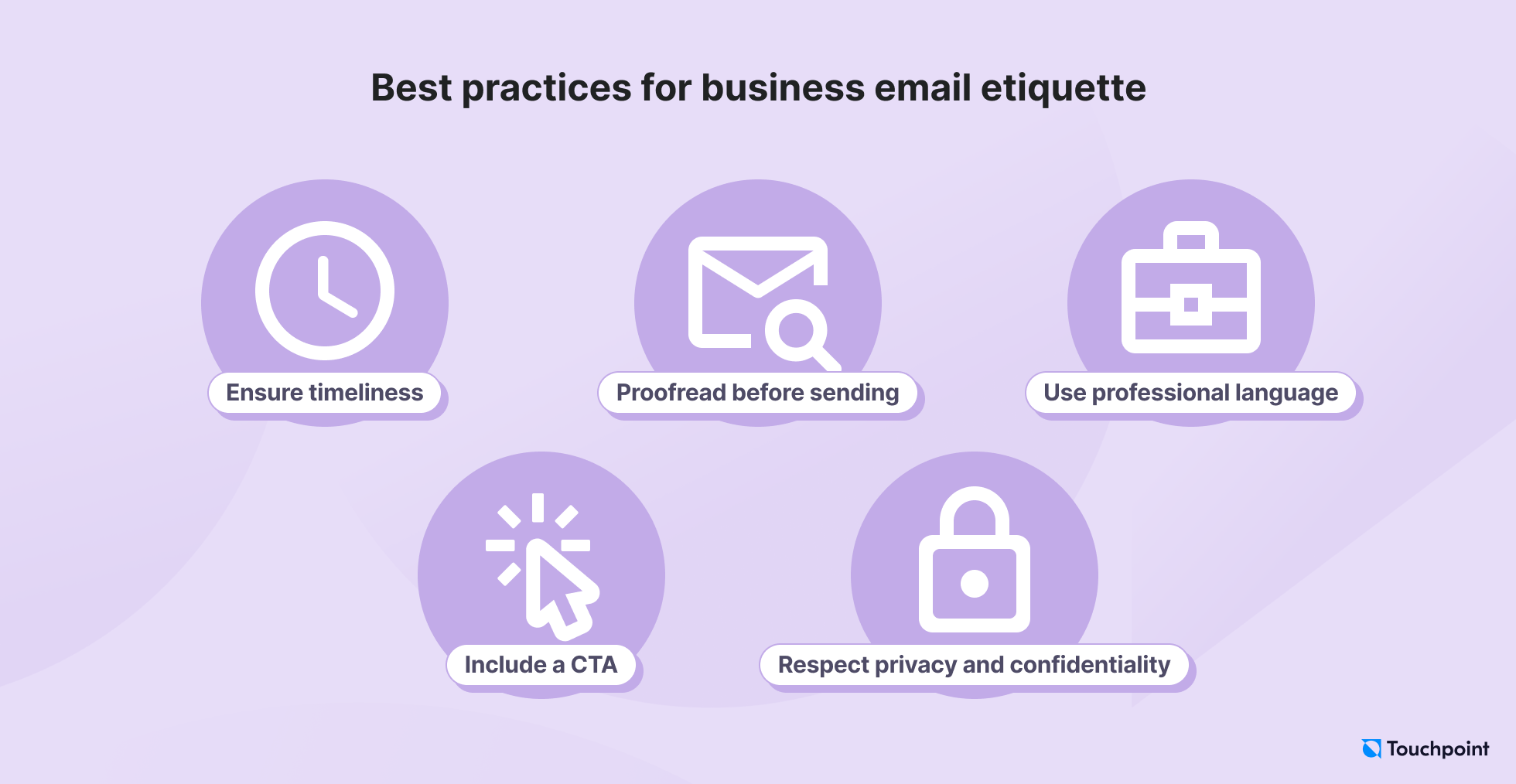
Ensure timeliness
- Responding to emails right away shows respect for the recipient’s time and keeps projects moving smoothly.
- Aim to respond within 24 hours or set expectations for when you will follow up.
Proofread before sending
- Take the time to check for spelling, grammar, and formatting mistakes.
- Consider using AI-powered grammar checkers for an extra layer of review.
Use professional language
- Maintain a formal tone in your emails.
- Avoid using slang or overly casual language.
Include a CTA
- Clearly state the desired outcome to guide the recipient on what to do next.
- Examples of effective CTAs:
“Could you please review the attached document by the end of the week?”
“Let’s schedule a meeting for next week to discuss further.”
“Please confirm your availability for the proposed dates.”
Respect privacy and confidentiality
- Do not disclose confidential details without proper authorization.
- Consider using encrypted email services for secure communication.
10 tools for great business emails
From managing your inbox to automating repetitive tasks, the following tools can help you write exquisite business emails, save time, and build stronger relationships.
- Outlook provides a comprehensive suite for managing emails, calendars, tasks, and contacts.
- Gmail has a clean interface, ample storage, and seamless integration with other Google services.
- Specialized business email platforms like Zoho Workplace or Google Workspace provide tailored email solutions with business-specific features.
- Hemingway Editor focuses on simplifying and clarifying your writing.
- Grammarly can improve your email content by checking grammatical errors and suggesting better phrasing.
- Mailchimp provides customizable templates, segmentation, and automation for email campaigns.
- HubSpot is a comprehensive marketing automation tool with email templates, personalization features, and analytics.
- Yesware allows you to track email opening rates, link clicks, and presentation views.
- Mailtrack offers free email tracking for Gmail, sending real-time notifications when your emails are read.
Improve engagement with better business emails
In this article, we’ve explored how business email examples can transform your stakeholder communication. Remember, it’s all about understanding your audience, crafting compelling messages, and using the right tone.
Now, it’s your turn to implement these tips. With the right approach, you can make your business emails more impactful.
Stay tuned to our content for further insights into improving your business communication!
Iustina Gherca
B2B Copywriter
Iustina is a curious copywriter with an analytical mind and a demonstrated history in the advertising industry. She likes mixing words with data and is passionate about human behavior. When she's not at her work desk, you'll probably find her enjoying refreshing tea flavors, spilling stories on paper, or binge-watching true-crime documentaries.






 PORTER business email example" width="1179" height="1751" />
PORTER business email example" width="1179" height="1751" />





















